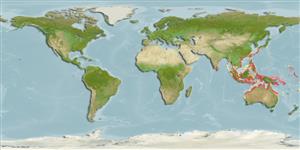>
Gobiiformes (Gobies) >
Oxudercidae (Mudskippers) > Periophthalminae
Etymology: Boleophthalmus: Name from Greek, ßoƛɛ for ejected and 'ophthalmos' for eye; refers to species capability to rapidly raise their eyes above the level of their orbital cavities, as if the eyes were being ejected..
Environment: milieu / climate zone / depth range / distribution range
Ecología
marino; agua dulce; salobre demersal. Tropical
Distribución
Países | Áreas FAO | Ecosistemas | Ocurrencias, apariciones | Point map | Introducciones | Faunafri
Indo-West Pacific: endemic to Australia.
Tamaño / Peso / Age
Maturity: Lm ? range ? - ? cm
Max length : 11.1 cm SL macho / no sexado; (Ref. 93058)
Radios blandos dorsales (total): 23-25; Radios blandos anales: 22 - 24. Distinguished by the following characteristics: total elements in D2 23-25; caudal fin length 17.9-24.6% SL; head length 26.6-31.1 % SL; length of D2 base 38.2-43.5%; first D2 element usually segmented and unbranched; longitudinal scale count 89-111; predorsal scales 38-60;
lower jaw teeth atypical for Boleophthalmus, notch lacking, teeth more rounded than congeners (Ref. 5218).
Facultative air-breathing (Ref. 126274); Amphibious air-breather (Ref. 31184). Max. length (Edward O. Murdy, pers. comm., 2000).
Life cycle and mating behavior
Madurez | Reproducción | Puesta | Huevos | Fecundidad | Larva
Kailola, P.J., 1991. The fishes of Papua New Guinea: a revised and annotated checklist. Vol. III. Gobiidae to Molidae. Research Bulletin No. 41, Research Section, Dept. of Fisheries and Marine Resources, Papua New Guinea. 153 p. (Ref. 6771)
IUCN Red List Status (Ref. 130435)
Threat to humans
Harmless
Human uses
Más información
PaísesÁreas FAOEcosistemasOcurrencias, aparicionesIntroduccionesStocksEcologíaDietacomponentes alimenticiosconsumo de alimentoRación
Nombres comunesSinónimosMetabolismoDespredadoresEcotoxicologíaReproducciónMadurezPuestaAgregación para la puestaFecundidadHuevosEgg development
ReferenciasAcuiculturaPerfil de acuiculturaRazasGenéticaElectrophoresesheritabilidadEnfermedadesProcesamientoNutrientsMass conversion
ColaboradoresImágenesStamps, Coins Misc.SonidosCiguateraVelocidadTipo de nataciónSuperficie branquialOtolitosCerebrosVisión
Herramientas
Special reports
Download XML
Fuentes de Internet
Estimates based on models
Preferred temperature (Ref.
123201): 25.4 - 29.2, mean 28.4 °C (based on 1050 cells).
Phylogenetic diversity index (Ref.
82804): PD
50 = 0.5156 [Uniqueness, from 0.5 = low to 2.0 = high].
Bayesian length-weight: a=0.00724 (0.00336 - 0.01560), b=2.95 (2.76 - 3.14), in cm total length, based on LWR estimates for this (Sub)family-body shape (Ref.
93245).
Resiliencia (Ref.
120179): Alto, población duplicada en un tiempo mínimo inferior a 15 meses (Preliminary K or Fecundity.).
Fishing Vulnerability (Ref.
59153): Low vulnerability (10 of 100).
